What to Look for When Buying Fresh Meat
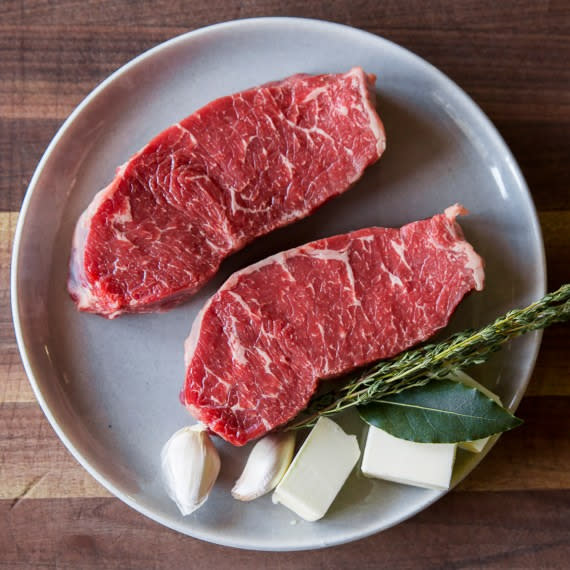
(Via ChefSteps Team of ChefSteps)
Get the most bang for your buck at the butcher counter by going in as an informed shopper. Here we break down what you need to know to buy the freshest meat.
When you look into a butcher’s case or peruse the meat aisle at your local grocery store, you’ll see what looks like a lot of the same thing, so how do you know which piece is right for braising, and which is best for steak? Once you know what beef cuts to look for, it’s easy to bring home the right cut for your dinner. All you have to do is understand a handful of broad, simple concepts about what makes a piece of meat tough or tender. Understanding and recognizing qualities that make up a piece of meat will empower you to choose meat for any occasion.
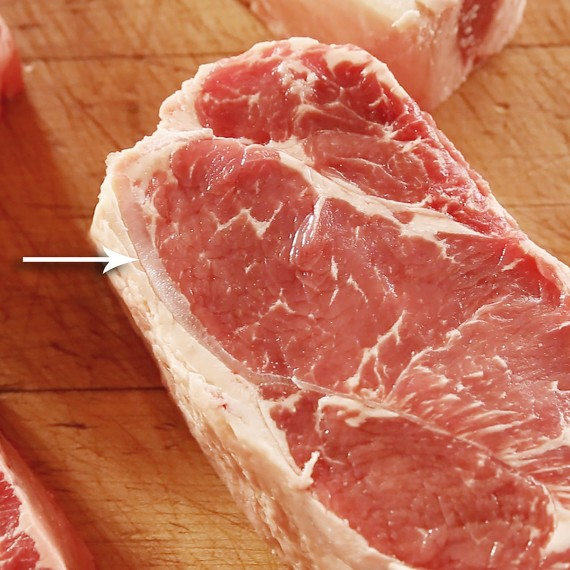
Tender meat should have very fine clusters of muscle fibers that feel soft to the touch.
Choose tender cuts of meat with only one muscle, or as few muscles within the cut as possible. Multiple muscles basically indicate a greater amount of connective tissue, and the fibers of each muscle tend to run in different directions. Together these factors make for a tougher steak.
This thick ribbon of connective tissue in a New York strip steak will be very chewy. Look for steaks with little or no connective tissue.
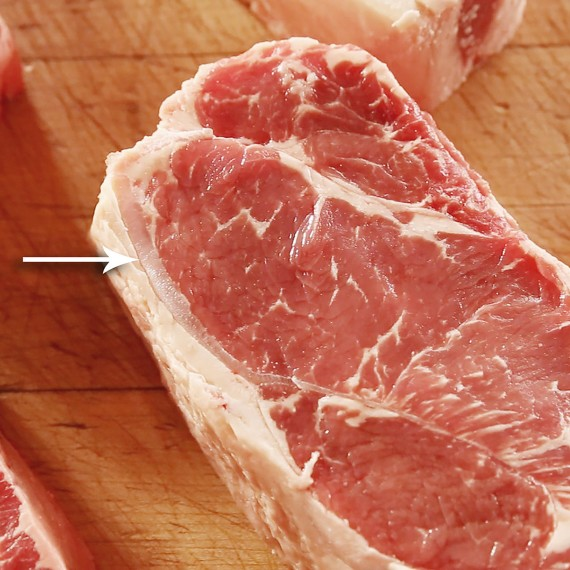
Connective Tissue Makes Tender Cuts Chewy
Even beef cuts that are tender can have unfavorable qualities. For example, the nerve end of the strip loin, located at the rear of the muscle from which New York strip steaks are cut, can sometimes have a very thick ribbon of connective tissue running into the meat, which is extremely chewy to eat.
This connective tissue is a good thing if you braise the meat, giving it the time and temperature it needs to break down into delicious gelatin. But when we briefly cook tender cuts at relatively low temperatures, like with this New York Steak with Red Wine Sauce, there isn’t time for the connective tissue to break down and become tender. So when purchasing a tender cut of meat from your butcher, always inspect the meat to make sure there is no unwanted connective tissue.
Choosing Fatty or Lean Steaks
Meat with a lot of visible fat (marbling) usually has a more robust, intense flavor than lean meat. It can be expensive (simply because fattening up a cow is a costly process), and it can also make for a chewy eating experience if not cooked properly. Some cooks think steak with a lot of marbling makes the meat more tender, but in fact, it can be just the opposite: It can make the steak tough and leathery. Meat with extreme marbling is usually best when shaved thin (as in carpaccio), or chopped up (as in tartare). This way, the “chewing” process is already done for you, and you’re free to enjoy the robust flavor of the well-marbled meat.
Inherently lean cuts (like a filet mignon, for example) are often very tender, but can have a blander flavor profile. That’s because muscles that work a bit harder in life will tend to accumulate more of the proteins and fat that contribute to the meaty flavor, at the expense of becoming less tender.
When shopping for steaks, it’s often best to seek a happy medium between lean and fatty. Look for steaks with some marbling, but not completely riddled with fat throughout. Try filet mignon for tenderness, or ribeye or strip loin for a balance between tender and flavorful.
Expensive vs. Inexpensive Steaks: Knowing What Really Matters
In general, it won’t work to choose cuts based on brand, producer, grade, or price alone. It’s always best to inspect the meat for desirable qualities instead. (That is, unless you’re dedicated to the practices of a certain producer or company.) When faced with options at the butcher counter, look for steaks with one uniform muscle, without any visible connective tissue. Steaks like that, no matter how expensive, when cooked properly, will be tender, juicy, and flavorful. Just because a steak is expensive doesn’t mean it will be delicious.
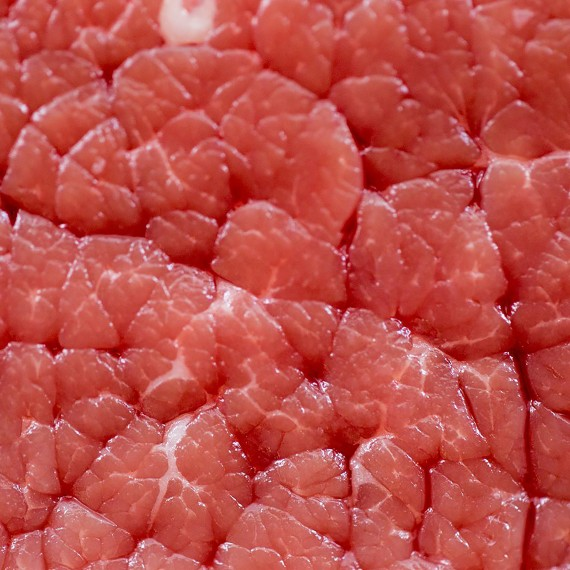
You can tell this beef brisket will be tough because it has obvious, visible muscle fibers. A tender cut of meat will have a more uniform texture.
SELECTING TOUGH CUTS
When purchasing tough cuts like brisket or chuck, always look for four things:
Coarse muscle grain
Lots of connective tissue
Multiple muscle groups
A good amount of fat
If you want a very succulent piece of meat that will melt in your mouth after braising, choose a piece with some, or all, of these features. Short ribs or fatty chuck will work perfectly.
Good to know: Visible muscle grain is good for tough cuts.
Look for coarse meat grain, with bundles of fibers you can clearly see. This coarse grain is a sign that the meat was once a strong and hardworking muscle, so when cooked low and slow, it will reward you with a succulent and tender braised texture. Brisket is a great example of a tough cut with very coarse muscle grain that is ideal for slow cooking, like in this Red Wine Braised Beef recipe.
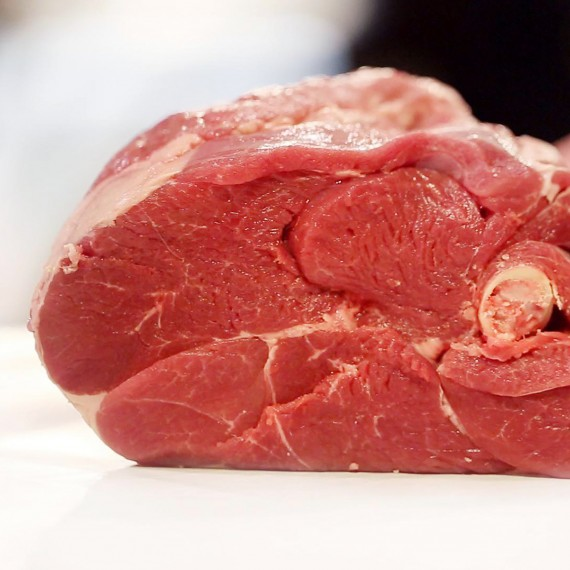
Connective Tissue and Fat: Good for Tough Cuts
Connective tissue is mostly made of collagen, a family of proteins that can be unwound into tender, succulent gelatin when cooked for long periods of time. Gelatin is what creates the flaky texture and succulence that’s so iconic and appealing in braised meat.
Most connective tissue is too fine to see, but the silvery sheath that surrounds and separates individual muscles in some cuts is a visible example of connective tissue. The piece of meat pictured below has lots of muscles grouped together, with each muscle bundled in a skin of connective tissue.
Fat also tends to surround muscles and can be distinguished from connective tissue by its opaque appearance and waxy feel when cold. Abundant fat “marbled” into the muscle makes for a flavorful braising cut, but too much fat surrounding a cut of meat will just yield unpleasant gristle in the final dish – we recommend trimming away excessive amounts of surrounding fat.
More from Martha Stewart:
20 Classic Comfort Food Recipes from Martha Stewart
36 Dinners You Can Make in Just 15 Minutes!
42 Slow-Cooker Recipes Worth the Wait
DIY Dried Fruit Granola Bites
Very Green Cucumber and Pear Juice
